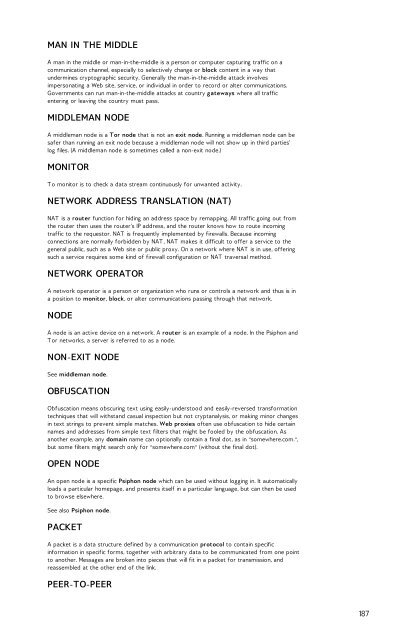CIRCUMVENTION TOOLS - FLOSS Manuals
CIRCUMVENTION TOOLS - FLOSS Manuals
CIRCUMVENTION TOOLS - FLOSS Manuals
Create successful ePaper yourself
Turn your PDF publications into a flip-book with our unique Google optimized e-Paper software.
MAN IN THE MIDDLE<br />
A man in the middle or man-in-the-middle is a person or computer capturing traffic on a<br />
communication channel, especially to selectively change or block content in a way that<br />
undermines cryptographic security. Generally the man-in-the-middle attack involves<br />
impersonating a Web site, service, or individual in order to record or alter communications.<br />
Governments can run man-in-the-middle attacks at country gateways where all traffic<br />
entering or leaving the country must pass.<br />
MIDDLEMAN NODE<br />
A middleman node is a Tor node that is not an exit node. Running a middleman node can be<br />
safer than running an exit node because a middleman node will not show up in third parties'<br />
log files. (A middleman node is sometimes called a non-exit node.)<br />
MONITOR<br />
T o monitor is to check a data stream continuously for unwanted activity.<br />
NETWORK ADDRESS TRANSLATION (NAT)<br />
NAT is a router function for hiding an address space by remapping. All traffic going out from<br />
the router then uses the router's IP address, and the router knows how to route incoming<br />
traffic to the requestor. NAT is frequently implemented by firewalls. Because incoming<br />
connections are normally forbidden by NAT , NAT makes it difficult to offer a service to the<br />
general public, such as a Web site or public proxy. On a network where NAT is in use, offering<br />
such a service requires some kind of firewall configuration or NAT traversal method.<br />
NETWORK OPERATOR<br />
A network operator is a person or organization who runs or controls a network and thus is in<br />
a position to monitor, block, or alter communications passing through that network.<br />
NODE<br />
A node is an active device on a network. A router is an example of a node. In the Psiphon and<br />
T or networks, a server is referred to as a node.<br />
NON-EXIT NODE<br />
See middleman node.<br />
OBFUSCATION<br />
Obfuscation means obscuring text using easily-understood and easily-reversed transformation<br />
techniques that will withstand casual inspection but not cryptanalysis, or making minor changes<br />
in text strings to prevent simple matches. Web proxies often use obfuscation to hide certain<br />
names and addresses from simple text filters that might be fooled by the obfuscation. As<br />
another example, any domain name can optionally contain a final dot, as in "somewhere.com.",<br />
but some filters might search only for "somewhere.com" (without the final dot).<br />
OPEN NODE<br />
An open node is a specific Psiphon node which can be used without logging in. It automatically<br />
loads a particular homepage, and presents itself in a particular language, but can then be used<br />
to browse elsewhere.<br />
See also Psiphon node.<br />
PACKET<br />
A packet is a data structure defined by a communication protocol to contain specific<br />
information in specific forms, together with arbitrary data to be communicated from one point<br />
to another. Messages are broken into pieces that will fit in a packet for transmission, and<br />
reassembled at the other end of the link.<br />
PEER-TO-PEER<br />
187

















